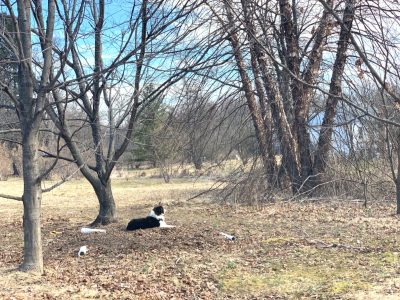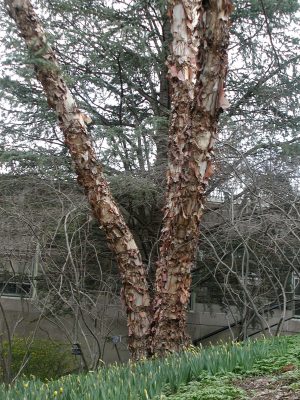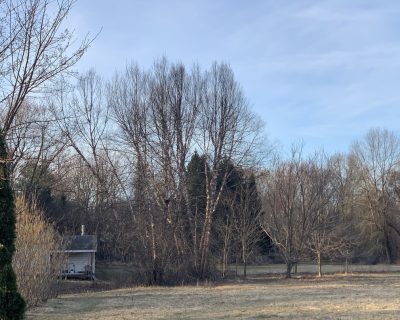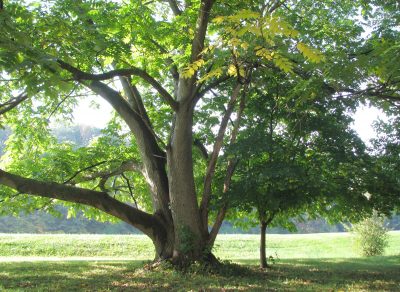INTO THE WOODS
Forest Garden Skeptic
“Forest gardening” or “agroforestry” has increasing appeal, and I can see why. You have a forest in which you plant a number of fruit and nut trees and bushes, and perennial vegetables, and then, with little further effort, harvest your bounty year after year. No annual raising of vegetable seedlings. Little weeding, No pests. Harmony with nature. (No need for an estate-size forest; Robert Hart, one of the fathers of forest gardening, forest gardened about 0.1 acre or 5000 square feet.)

Is this a forest garden?
Do I sound a bit skeptical? Yes, a bit. Except in tropical climates, forest gardening would provide only a nibble here and there, not a significant contribution to the diet in terms of vitamins and bulk. A major limitation in temperate climates is that most fruit and nut trees require abundant sunlight to remain healthy; the same goes for most vegetables.
The palette of perennial vegetables in temperate climates is very limited, especially if you narrow the field down to those tolerating shade. I’m also not so sure that weeding would be minimal; very invasive Japanese stilt grass has been spreading a verdant carpet on many a forest floor whether or not dappled by sunlight.
The case could be made — has been made — that some of the dietary vegetable component could be grown on trees. Robert Hart wrote of salads using linden tree leaves instead of annuals such as lettuce and arugula. I’ll admit that I’ve never chewed on a linden leaf. (I’ll give it a try as soon as I come upon one that has leafed out.) My guess is that its taste and texture would leave much to desire.
And how about squirrels? I grow nuts, and part of my controlling them involves maintaining meadow conditions around the trees. This exposes them to predators, including me and my dogs, without their having tree tops to retreat to and travel within. Unprotected, I’ve had nut plants stripped clean by squirrels.
The book Edible Forest Gardens by Dave Jacke offers a very thorough exploration of forest gardening.
But Did I Plant a Forest Garden?
I’ve actually planted a forest garden! Well, perhaps not a forest garden. Over 20 years ago, I did plant a mini-forest. My forest, only about 300 square feet, was originally planted for fun (I like to plant trees), for aesthetics, and for some nutrition. So far I’ve reaped immense visual rewards for my effort.
Here’s what I planted: Bordering a swale that is rushing with water during spring melt and periods of heavy rain went four river birch (Betula nigra) trees. They evidently enjoy the location for they’re now each multiple trunked with attractively brown, peeling bark and towering to about 60 feet in height.

River birch
I also planted 3 sugar maple trees to provide sap for maple syrup for the future. The future is now (except I no longer use enough maple syrup to justify tapping them.) I also planted a white oak (Quercus alba), whose sturdy limbs, I figured, would slowly spread wide with grandeur in about 150 years, after the maples and birches were perhaps long gone. Unfortunately, the white oak died, probably due to winter cold; its provenance was a warmer winter climate. My mistake.
I also planted a white oak (Quercus alba), whose sturdy limbs, I figured, would slowly spread wide with grandeur in about 150 years, after the maples and birches were perhaps long gone. Unfortunately, the white oak died, probably due to winter cold; its provenance was a warmer winter climate. My mistake.
Since that initial planting, I’ve also planted a named variety of buartnut (Juglans x bixbyi), which is a hybrid of Japanese heartnut and our native butternut.

Buartnut (not mine, yet)
I hadn’t realized it, but that tree has grown very fast and now spreads its limbs wide in much that habit as a white oak. The other two trees that I planted are named varieties of shellback hickory (Carya laciniosa). These trees are slow growing but eventually will offer good tasting nuts. They’re quite pretty, even now, with their fat buds.
A Vegetable Also
What about vegetables in my mini-forest? They were not part of my original plan. It turns out that ramps, a delicious onion relative, a native, which I’ve been growing for a few years beneath some pawpaw trees, are spring ephemerals. Spring ephemerals are perennial plants that emerge quickly in spring to soak up sunlight before its blocked by leaves on trees, then grow and reproduce before the tops die back to the ground.
Ramps (Allium tricoccum) are perfect forest vegetable, so I wanted to make the ground beneath my mini forest more forest-y before moving the ramps from beneath the pawpaws. Nothing fancy. All I did was to haul in enough leaves to blanket the ground in the planting area a few inches deep. That leafy mulch will suppress competition from weeds and add organic matter to the soil.

Collecting ramps for transplanting
In just a few years, the ramps will be sufficiently established to provide good eating, perhaps along with some buartnuts and hickory nuts, all from my forest(?) garden.
Drip Opportunity
I’m looking for a site within 20-30 minutes of New Paltz, NY in which to hold a drip irrigation workshop. What I need is a vegetable garden in beds (not necessarily raised beds) for which I would design a drip system. Workshop attendees I would install the system after learning about drip irrigation. Host pays fo materials. Contact me if interested.


I have 7 raised beds (5×10) set on a grassy slope. In Gardiner. Plenty of space for workshop attendees. I can send photos if you are interested.
Thanks, but I’m holding off on doing group anything for the coming weeks (or months) because of COVID-19.
Thanks for your comments about forest gardens. Have you ever tried to develop a “fruit guild”? What do you think would be the success of that? I live in Zone 5
Problems to consider: shade; potential for a tangle of unruly stems making pruning more difficult; less efficient production and harvest.
Too bad I’m over an hour north! I just re-did my vegie garden with 16 4′ X 4′ framed beds inspired by those at the Berkshire Botanic Garden. Even though I use drip irrigation in all my hoop houses, I haven’t a clue how to use it in the veggie garden with that configuration!
Two or three lines per bed, valves to turn water off for unused beds, 1/2 inch mainline tubing, and pressure compensating drip lines if all beds aren’t on the same level.
Miracle Farms in Southern Quebec is doing some inspiring work. Here are two videos:
https://www.youtube.com/watch?v=3riW_yiCN5E
https://www.youtube.com/watch?v=b9Bf4F25Hbw
Thanks. (I am familiar with the place.)
I’ve found Martin Crawford’s “Creating a Forest Garden” to be the best resource for the creation of “Forest Gardens” which are really better off called “Savannah Gardens” (Though this doesn’t sound quite as good). Crawford advocates planting trees quite far apart to allow sufficient sunlight to the understory. I’ve had quite a lot of trouble planting out even a small area of heavy shade on my property with edible plants that will actually thrive there. Nearly everything would be happier growing in the sun.
Thanks for the suggestion and comments.
How about our Morrell Mushroom’s?? When should we start watching closely for them and where??
I have very little knowledge about mushrooms beyond what little is needed to raise shiitakes on logs.
Dear Lee,
Though I live in Michigan the climate in upstate NY is very similar. I live in a relatively low snow area-Detroit. However I stumbled upon your blog looking for something else. My own house is surrounded by a lot of trees so I actually am in a public garden. Ive been eating many of the wild things that I used to throw away (purslane, lambs lettuce, parts of the daylilies). Because I have so many trees at home I grow a lot of hostas at my house. When the little spikes pop up in the spring they make quite a tasty asparagus like dish. I only eat the white flowering varieties. They grow prolifically and like a lot of things like ramps will feed you forever as long as you dont over harvest them. I’m told that they appear in Japanese vegetable catalogs under the title forest vegetable. Just a note. Sincerely,
Kennard Duda
Hmmm. Interesting. Deer love them also.
All hosta species are edible, and all of the ones I’ve tried have been very tasty, like a tender asparagus. The spring shoots are grown commercially in japan and are called “urui”. The blanched shoots are called “snow urui”. Definitely worth trying since you can harvest the Spring shoots of mature plants, and they’ll send up a new flush of leaves and look as good as new later in the season. Obviously bigger leaved varieties are preferred since they provide more edible material.
I get it, if all you had was a forest, then plant it.
However sun loving plants will live and grow in the sun, much better than in partial shade.
Food forest is okay for a 1/10 acre, but 1/2 to 10 acres you can segregate for the area that the plant needs. The native Americans burned the grass land to get wild crops to grow & multiple. So much of the Food forest thing is a romantic fantasy. But if it works for you, I wish you well.
I will plant my sun chokes & asparagus in the sun in beds.
Just love your posts, both for the straight forward commentary and the things I learn about so many different types of plants/tree. I hear what you are saying about Forest Gardens. While I do have some perennial vegetables, I don’t really get the yield I would need for food security from them, and some, like Jerusalem Artichoke, and Skirret, are so invasive I don’t want them at Bramblewood. I like the ‘idea’ of this, but in practice I think it would take a different climate (as you noted) and a fairly large piece of land. Animal predation means that we have no choice but to manage the crops and protect them if we want a reasonable harvest. I feel similarly ambivalent about “Re-wilding.” If too many of us (and that wouldn’t be a very large number) go rushing into wild area to harvest, it could have a disastrous effect on those forests and fields. We simply don’t have the surplus of these wild plants or wild places remaining to do this. I think a balance is good. But we have all learned what happens when too much ‘wild-crafting’ happens. Populations of these special plants diminish and disappear. I’m not saying we should never take any at all, but the gathering has become too indiscriminate, IMHO.
Early on in your ramp explorations, you mentioned wondering whether these forest plants might actually do better in more direct light similarly to understory plants like pawpaws. I was wondering if you ever did this sort of comparison, and whether you determined what environment works best for ramps. I am designing a new garden that will have a sunny allee of fruit trees mulched with shredded leaves, as well as a substantial wooded area, and I was wondering where to focus my ramp energy. Also, do you have any thoughts on whether indoor germinating and pot raising for a season works better than natural seeding (other than potentially speeding things up a year)?
I have seen ramps thriving inthe wild as understory plants, so that is the environment I am re-creating for them. So far, growing them from seed in pots has not been successful for me.